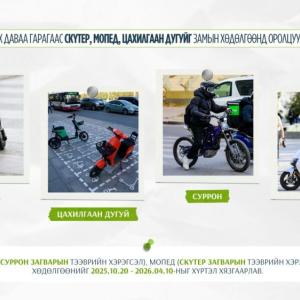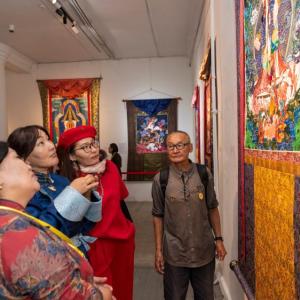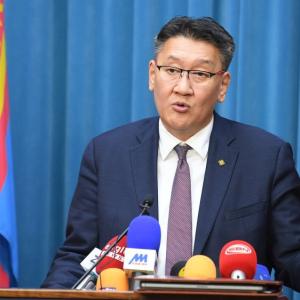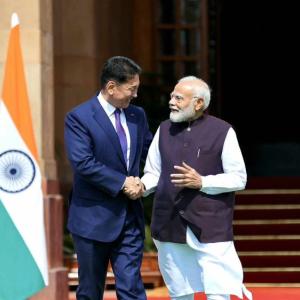M.Munguntsetseg: Xiongnu ‘biyelgee’ is capable to be well-known in the world
The Mongol Messenger
Ulaanbaatar /MONTSAME/. MONTSAME interviewed the Choreographer, Researcher, Founder of “Nature Dance Production”, M.Munguntsetseg about the origins, features and development of ‘biyelgee’ which is a genre of Mongolia traditional dance.
-Let’s
start our interview with the history of this genre of dance. When did this
genre originated?
This is quite a controversial topic. Some say it originated during the times of Xiongnu, Xianbei or Juan-juan also known as Ruruan. At that time, it was often considered more as a dance. There is a word ‘buzi’ in a dictionary created by Mahmud Al Kashkar in 1077. The alphabets J, Z, Ts, Ch are pronounced same in the Xiongnu language which made the word ‘buzi’ ‘buji’ and the alphabet ‘g’ was added to create a noun. This is how the word ‘bujig’ (the word ‘dance’ in Mongolian) was created and it made it clear that we have been using the word ‘bujig’ at least for the last one thousand years. Same goes for its existence.
-How
many types of ‘biyelgee’ are there? And how did we inherit this?
People often find ‘biyelgee’ a dance of western Mongolians, but it belongs to the whole Mongolians. It is just some minority ethnic groups in Mongolia name it differently, but the concept itself is similar to each other. For example, Buryats say ‘khatirakh’, western Mongolians say ‘biyelekh’, while central Khalkhas say ‘bujiglekh’ etc.
-What
makes this genre of dance different from others?
It is not possible for the human to fully reflect horse’s movement by their feet. But it is possible to express it by using upper part of the body, specifically shoulders, ribs etc. North Americans and Irish people do step dance by mainly using their feet, while shoulders and upper part of body plays important role in dancing ‘biyelgee’. This is what makes it different from others.
-Is
‘biyelgee’ only in Mongolia? Or are there any countries that have something
similar?
There are some similar types of dances among Australian and African native tribes. But Mongolian ‘biyelgee’ has its own soul that differs itself from others. For example, Mongolians reflect their lifestyle, culture and daily ritual in their dance movements.
-At
what occasions did Mongolians dance ‘biyelgee’?
‘Biyelgee’ was often danced since the ancient times when they pray for the Eternal Blue Sky. Moreover, during the occasions: before hunting, wedding ceremony, burial rituals etc.
-It is
said that biyelgee has some elements of contortion. Are there any connections
between them?
Tsetseg soum of Khovd aimag is the birthplace of my grandmother. Many great contortionists were born from that place. Therefore, Khovd and Uvs aimags considered as two of the aimags still carrying their traditional heritages. In my opinion contortionists born from Tsetseg soum of Khovd aimag are very good at dancing ‘biyelgee’. In my previous experiences I also have noticed that biyelgee and contortion have connection and similarities to each other.
-I
have heard from many tourists that Mongolian traditional dance movements are
very elastic. Is being elastic somehow relates to ‘biyelgee’? Or is it just the
way of traditional dance?
As Mongolia is situated in highly elevated geographical location, the people here are used to endure both hot and cold climate. Therefore, it has been noticed that the people’s bodies are elastic regarding to the lifestyle the people go through.
Predator type animals, the cat-type tiger, the leopard and the wolf are very elastic. Particularly elastic with their back. They can get through even the narrowest holes. Therefore, I think the Mongols are very elastic which is probably related to their diet. We eat a lot of meat due to the weather and climate. It has been shown that the Asian and European nations who eat seafood are kind of stiff. I taught some foreign professional dancers ‘biyelgee’ when I was a teacher in University of Taiwan. It was really hard for them to learn, while Mongolians I have taught learnt it very quickly. Therefore, I came to a conclusion that the ‘biyelgee’ is a wonderful genre of dance perfectly suited to Mongolians. Every Mongolian has natural-born ability to dance ‘biyelgee’.
I have taught ‘biyelgee’ in numerous countries including Netherlands, Austria, Germany, China, Korea, Japan, Hong Kong, Taiwan etc. They learn the techniques, but they somehow lack the spirit and soul.

-Could
you please briefly tell us about the health benefits of ‘biyelgee’?
This is one of the many topics that I have been studying for the last 10 years. It is helpful not only Mongolians but also foreigners. When you dance ‘biyelgee’ the core back bones also move along because the shoulder and ribs move while dancing. As you move your spine, all the veins, or nerves, move along the path, so that the viruses and dirty air trapped in your body moves out. In classical dance, the emphasis is on tightness and a beautiful form. But when it comes to ‘biyelgee’, it unleashes the whole body, and it allows the dancer to fully feel its muscles and organs.
My teacher D.Nanjid used to say that “Dancing ‘biyelgee’ makes your inner self sing”. Therefore, it is really beneficial for the health of the person who listens to his inner self while moving its body bones. It is good that yoga, classical dance and other types of dance schools are being established in Mongolia. But for a Mongolian, if you take care of yourself and dance ‘biyelgee’, at least you will not get the flu. I want everyone living in polluted cities such as Ulaanbaatar to learn how to dance ‘biyelgee’.
And it needs to be thoroughly studied from the perspective of medical science. The life expectancy and life style of Oirat Mongols prove its significance to life. We have got in touch with some medical research institutions and their approach seemed too much European and equipment-intensive. Of course, getting proved by medical research is a matter of time.
-How ‘biyelgee’ is
evolving over the time?
Although Mongolian traditional dance, ‘biyelgee’ have been
registered in the UNESCO World Heritage List in 2009, it is not developing very
well. Researchers, professionals, and university teachers need to be involved
in developing this genre. I recently took a course on intangible heritage from
the UNESCO Center in Beijing.
According to the teacher at the Australian Cultural Heritage Training Center, I am a heritage bearer. I know more than 50 types of ‘biyelgee’ as I have done many studies in western aimags. In doing so, I realized that ‘biyelgee’ had to be translated correctly. For example, some ethnic groups had 4 or 5 types of ‘biyelgee’ in the past, but now it reached around 14. Most importantly, new types of ‘biyelgee” are emerging. Therefore, we have to distinguish newer types of ‘biyelgee’ from the traditional ones. Otherwise, it may be harmful to teach wrongly or to enrich one’s own movement by mixing it with another. The history can never be distorted; the basic rhyme should never be altered. No one can update without relying on historical sources.
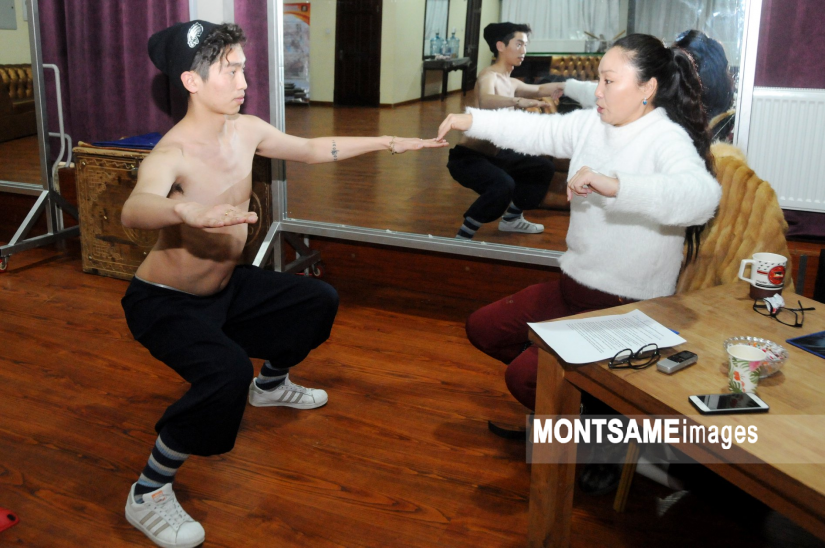
-When
did you start teaching? And how many students do you have? Could you name some
of them?
When I was in school, I did not know what was ‘biyelgee’. My family often participated in All People’s Art Festival. At that time, I used to imitate the elders dancing ‘biyelgee’ a lot. From the age of 7, I have been practicing dance for 42 years. In 1993, my teacher D.Nanjid established “Dunjingarav” ensemble and I attracted to his way of teaching ‘biyelgee’. Since then, I have been practicing traditional Mongolian dance.
Working in the Mongolian University of Arts and Culture for
15 years got me many students. 40-60 students graduate from my department each
year. Half of them are my students. All the dancers of “Tumen Ekh” ensemble
after the year of 2000 are my students. For example, famous dancers E.Undral,
T.Sodgerel, Ch.Seseerkhuu etc.
I want all the choreographers including my own students to be intelligent and do whatever they are doing based on research.
-The
HU band is becoming more and more well-known in the world by using khoomei and
traditional instruments. Is it possible for Mongolians to be well-known in the
world by traditional dance or ‘biyelgee’?
I worked as a teacher in Vienna, Austria at the invitation of International Modernist Center. At that time, I was often asked “Where did you learn this modern exercise?”. And I replied “this is our traditional Mongolian dance ‘biyelgee’” and they really enjoyed the effectiveness of ‘biyelgee’ and they were saying that it was warming the body within just 3-5 minutes. As I mentioned before upper parts of human body especially ribs and shoulders are often used to dance ‘biyelgee’ and it boosts blood circulation which warms up the body. Warming up before practicing any types of movement prevents from any possible injuries. This is one of the parts that amazes the foreigners.
About “The HU”, me and my director D.Enkhbayar met with the founder and producer of the band B.Dashdondog 2 years ago when the band was just about to be formed. He asked our opinions on how we can enrich the band with our dances. Our “Nature Dance Production” has many unique choreographs that other ensembles or productions do not have.
Xiognu ‘biyelgee’ is absolutely capable of being well-known
in the world. We are planning to conduct quite an intensive research on the
history of Mongolian traditional dance in order to get to know more about our
history and culture as well as to explore the true potential of Mongolian
traditional dance.
 Ulaanbaatar
Ulaanbaatar







